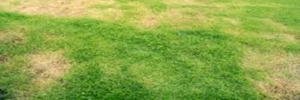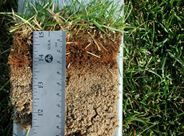There is something appealing about a healthy green yard that just invites you to bust out the bocce! A lawn that looks dull, patchy, and doesn’t respond to watering can be frustrating and disappointing … and perhaps lead to a little yard envy.
All living things reveal signs of a stressful environment and your grass is no different. But don’t blame your grass! What lies underneath is likely responsible. Compact soil and dense thatch are often the underlying source of a distressed-looking lawn.
There are a number of reasons soil can get compacted and negatively affect turf health. The soil quality itself may be heavy or contain clay; your yard may see a lot of foot traffic from children and pets; even normal wear from yard maintenance with heavy equipment like mowers, can all lead to compact soil. If the soil is too packed down vital nutrients can’t find their way to the roots of your grass.
Spring or fall are the best time to capitalize on the growing season of your grass. Annual deep core aeration and overseeding go hand in hand to take a tired, stressed out yard and transform it into a bright, lush landscape.
Here are 4 indicators that your yard is trying to tell you something.
Four signs your yard is distressed:
Poor Texture & Growth
If your grass is thinning and appears to be growing poorly, your turf is likely complaining about a lack of nutrients. In a well enjoyed yard, a patchy area here and there are perfectly normal signs of wear and tear. However, if there are significant thinning and growth problems, tightly packed soil is likely your culprit. This prevents oxygen and water from carrying nutrients to the roots. No nutrients, no growth.
Discolouration
Another sign of nutrient distress is browning or yellowing grass. There can be several factors leading to the malnutrition of your lawn, and your lawn care technician can help you to determine the cause. But discolouration combined with signs of thinning and patchy areas are often a clear hint that it is time to aerate.
Pooling Water
Poor water absorption is another giveaway that compact soil is standing between you and a lush green yard. Examining your yard after watering can give you some clues whether your soil is too dense. Puddling, or runoff on sloped areas, signals that your watering efforts have met their match with the soil. This can be additionally frustrating if unabsorbed water is washing away newly distributed seed.
Water may also evaporate quicker than it should on compact soil leaving it dry instead of moist which is required for growth and germination. Thankfully deep core aeration can solve this issue, making sure your time and money in seed and watering are not washed away.
Excess Thatch
In addition to compact soil, excess thatch may be causing your turf to struggle. A tight weave of organic plant matter exists between your growing grass and the soil. Thatch is normal and even necessary to help protect your lawn and keep it robust. But when thatch is in excess of ½ inch thickness, the compressed bundle of roots, shoots, stems and leaves can block essential water and air.
Deep core aeration adds oxygen into the soil which is key for living microorganisms like earthworms to thrive. The work they do helps decompose the thatch. The cores or “plugs” left behind deep core aeration also help with the process of decomposition to get the ecosystem of your lawn healthy and thriving again. Certain types of grasses like Kentucky Blue Grass are a favoured choice in cooler climates for a hearty, lush lawn but also require regular dethatching and aeration to keep that luxurious look and feel.
Some of these signs of a stressed lawn are obvious, but there are a few things you can do to test the stress-level of your yard:
Digging Deeper
Thatch Test
If you’re worried you might have a thatch problem a quick thatch test will do the trick. Use a spade to slice out a wedge of turf a few inches into the soil. Thatch consists of the spongy layer above the soil and does not include dead or growing grass above it. Use a ruler to measure the thickness of the thatch up to the soil line. If your measurement is greater than ½” it is time to dethatch and aerate.
Screwdriver Test
A simple and quick way to check for soil compaction is the screwdriver test. Use a 6” screwdriver to pierce the soil. If it goes straight down with ease your soil and thatch are in good shape. If you meet resistance, it’s time for lawn care. You can also check the shaft for soil moisture an hour or so after watering. If it comes out clean that is a sign of dry soil. For large yards, you may want to do this simple check in a number of different spots.
Soil Test
Soil testing is a quick and inexpensive way to get baseline knowledge of the PH-level, essential minerals and other micronutrients you’re working with. You can purchase a home testing kit or send in a soil sample for lab testing and work from there to improve growing conditions of your soil.
So listen to your lawn! Contact Green Sprout Lawn Care to get the best in deep core aeration and seeding service for Edmonton and Surrounding Areas and boast a yard that everyone is talking about.
GREEN SPROUT LAWN CARE
EDMONTON & AREA LAWN CARE SERVICES
“LET US MAKE YOUR LAWN BEAUTIFUL!”
Green Sprout Lawn Care has served Edmonton and surrounding areas for 30 years.
We currently serve customers in Edmonton, Beaumont, Leduc, Nisku, Morinville, Sherwood Park, St. Albert, Sturgeon County, Strathcona County and Parkland County and all areas in between.
We specialize in commercial and acreage property care. Our awesome yard care is also available for residential homes in Edmonton and surrounding cities and towns as well. While lawn care services are our main focus, we want you to know that we do much more than that!
See our Services page for all that we offer!


